
Intersection car accidents are all too common in Indianapolis—and they don’t just affect drivers. Pedestrians and cyclists often pay the highest price. Whether you’re commuting through the city or driving through a neighborhood intersection, a sudden collision can turn your life upside down.
If you’ve been injured in a car accident, an experienced Indianapolis car accident lawyer can help you pursue the compensation you deserve. At Poynter & Bucheri, our accident lawyers are proud to serve individuals and families throughout Central Indiana with trusted legal guidance and passionate advocacy.
Call 800-265-9881 today or click here to schedule your free consultation and start building your case today with an accident lawyer that knows how to fight for what you’re owed.
Indiana Driver Intersection Laws
Indiana’s intersection laws are designed to keep traffic flowing smoothly while protecting everyone on the road. These rules apply at both controlled and uncontrolled intersections—whether you’re approaching a traffic light, stop sign, or roundabout.
If a motor vehicle accident or pedestrian accident occurs, insurance companies are the first to use these laws to assess fault and determine compensation. If you’ve been injured in a crash, an experienced car accident lawyer at Poynter & Bucheri can help protect your rights and get the financial recovery you truly deserve.
Controlled Intersections
At controlled intersections, drivers must follow traffic signs and signals to determine the right-of-way. These include:
- Red Lights: Come to a complete stop and wait for a green light before proceeding.
- Stop Signs: Stop fully and yield to any vehicles or pedestrians before moving forward.
- Yield Signs: Slow down and give the right-of-way to traffic when necessary to keep everyone safe.
These traffic control measures are vital for maintaining safety and preventing car accidents.
If you’ve been injured by a driver who disregarded these laws, don’t wait to take action. Contact an Indianapolis car accident attorney to protect your rights, file your insurance claim, and explore how a personal injury lawsuit can hold the responsible party accountable.
Uncontrolled Intersections
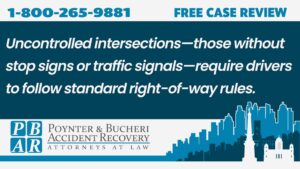
Uncontrolled intersections—those without stop signs or traffic signals—require drivers to follow standard right-of-way rules. These rules include:
- Vehicles Approaching Simultaneously: When two cars arrive from different directions, the driver on the left must yield to the driver on the right.
- Left Turns: Drivers turning left must yield to oncoming traffic that is already in the intersection or close enough to pose a danger.
- Pedestrians: Drivers must yield to pedestrians who are lawfully crossing, helping prevent serious pedestrian accidents.
These guidelines help keep traffic flowing safely, even in the absence of signs or signals.
If you were hurt in a crash at an uncontrolled intersection because another driver failed to yield, reach out to an experienced Indianapolis car accident attorney. The dedicated legal team at Poynter & Bucheri can help you hold the at-fault driver accountable and recover the financial support you need to move forward.
Types of Accidents That May Occur at Intersections
Intersections are high-risk areas for car accidents. With multiple traffic flows converging, they create risk for everyone. The potential for serious crashes, including fatal collisions, is especially high.
Understanding the types and how serious accidents occur at intersections can help you stay alert and take preventive measures. If you’ve suffered injuries in one of these incidents, an experienced Indianapolis car accident attorney can help you understand your legal options and pursue accountability.
Here are some of the most frequent types of intersection collisions:
Vehicle Accidents
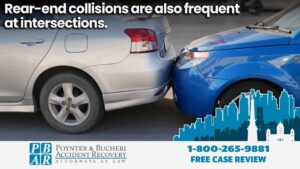
Intersections are common sites for serious collisions, especially T-bone crashes. These occur when one vehicle strikes the side of another, often due to a driver running a red light or failing to yield. When a truck driver is involved, the size and weight of a commercial vehicle can lead to far more severe injuries and extensive damage.
Rear-end collisions are also frequent at intersections, typically caused by distractions, tailgating, or abrupt stops. Even seemingly minor car accidents can result in lasting injuries like whiplash or property loss.
If you’ve been injured in a crash, a car accident lawyer can help you deal with the insurance company, protect your rights, and pursue the full compensation you’re entitled to.
Bicycle Accidents
Bicycle accidents at intersections are particularly dangerous because cyclists have far less protection than motor vehicle occupants. These collisions often happen when drivers fail to check for cyclists before turning, run red lights, or neglect to yield at crosswalks. Without the protection of a vehicle, these incidents can lead to catastrophic injuries or fatal crashes.
If you’ve been injured in a bicycle accident, speaking with a car accident attorney can help you pursue the financial support you need to recover—whether through an insurance claim or a personal injury lawsuit.
Pedestrian Accidents
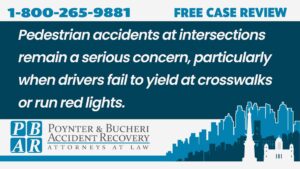
Pedestrian accidents at intersections remain a serious concern, particularly when drivers fail to yield at crosswalks or run red lights. While pedestrians can sometimes contribute to collisions by crossing outside of designated areas or ignoring signals, drivers have a greater duty to stay alert and avoid harm.
Pedestrians injured in these car accidents often suffer severe injuries due to their lack of protection. This highlights the ongoing need to prioritize pedestrian safety and exercise caution at all times.
If you’ve been hurt in a pedestrian accident, securing legal representation from an experienced car accident lawyer can help you obtain the financial support you need to recover.
Negligent Behaviors and Actions That Cause Intersection Accidents
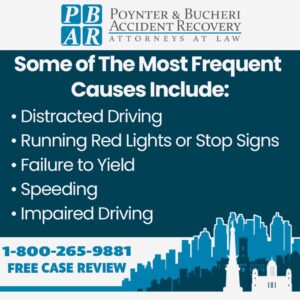
Indiana intersection accidents often occur due to negligent actions by drivers, cyclists, or pedestrians. Some of the most frequent causes include:
- Distracted Driving: A distracted driver, such as one texting or talking on the phone while driving, takes attention away from the road.
- Running Red Lights or Stop Signs: Leads to car crashes, often resulting in T-bone or rear-end accidents
- Failure to Yield: Especially when turning left or not giving the right-of-way to pedestrians or approaching traffic
- Speeding: A speeding vehicle increases the risk of accidents and the severity of car accident injuries.
- Impaired Driving: Impaired driving, like drunk drivers, slows reaction time and impairs judgment, increasing the risk of car crashes.
- Aggressive Driving: Behaviors like tailgating and weaving in traffic heighten the chances of a serious collision.
These behaviors make intersections especially hazardous for all road users. Whether you were injured in a pedestrian accident or car accident, understanding the cause is critical for building a strong claim.
If you’re considering an Indiana car accident case, you don’t have to face the process alone. Consulting with an experienced car accident lawyer can help you pursue fair compensation and guide you through the legal process.
Intersection Injuries That May Prove Fatal
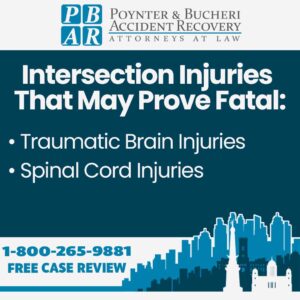
Motor vehicle accidents at intersections can lead to severe and sometimes fatal injuries. Pedestrian accidents in these areas are especially dangerous due to the lack of protection, often resulting in catastrophic outcomes. Two of the most serious injuries sustained in these collisions are traumatic brain injuries (TBI) and spinal cord injuries.
- Traumatic Brain Injuries (TBI): Often caused by a sudden impact to the head—such as striking the dashboard, steering wheel, or window—TBIs can range from mild concussions to severe brain damage. Serious cases may lead to permanent disability, coma, or even death.
- Spinal Cord Injuries: High-impact car accidents or ejections from the vehicle can damage the spinal cord, resulting in paralysis, loss of bodily function, or death due to disrupted communication between the brain and body.
Both injuries require immediate medical care and often lead to long-term recovery, permanent disability, or tragic loss of life. The physical and emotional toll is immense—and the financial burden from medical expenses can be overwhelming.
If you’ve lost a loved one in a fatal car accident, we understand that no amount of legal action can undo your pain. However, consulting with experienced car accident attorneys can help you pursue justice and secure the financial support your family needs to move forward.
How Fault is Determined After an Intersection Accident
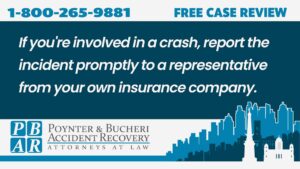
To resolve legal claims and insurance company disputes after an intersection accident, you’ll need to determine who was at fault. This involves evaluating several factors to identify the responsible party including:
- Traffic Violations: If a driver runs a red light, fails to stop at a stop sign, or doesn’t yield the right-of-way, they may be found at fault.
- Failure To Yield: A driver making a left turn without yielding to oncoming traffic or pedestrians may be held responsible.
- Negligence: Drivers who fail to give the right-of-way to cyclists or pedestrians legally crossing the intersection can be assigned fault.
- Driver Error: Mistakes such as misjudging the speed of another vehicle or failing to signal can lead to accidents and determine fault.
- Eyewitness Accounts: Statements from witnesses can help clarify the events, such as where the crash occurred and what led to the accident.
- Physical Evidence: Damage to vehicles, tire marks, or debris at the scene can help determine who was at fault.
- Traffic Camera/Dashcam Footage: In some car accident cases, video footage can provide crucial evidence to establish fault.
- Accident Reconstruction: In complex personal injury claims, an expert may analyze the accident to determine the sequence of events.
If you’re involved in a crash, report the incident promptly to a representative from your own insurance company. Pedestrian accidents and other serious intersection collisions often require a detailed investigation—not just by police but also by the insurance company representative involved in the claim.
Legal representation can help you navigate the claims process, ensuring that you are fairly compensated. In states like Indiana, comparative fault laws may apply, meaning fault can be shared among multiple parties, which can affect the amount of money awarded. Ultimately, fault is determined by carefully analyzing all available evidence in a personal injury case.
What is Shared Liability in an Intersection Accident?
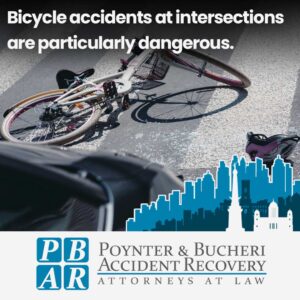
Shared liability occurs when more than one party is found responsible for a traffic accident at an intersection. This can involve drivers, pedestrians, or others whose negligence contributed to the crash.
In these cases, each party’s percentage of fault is evaluated. That percentage directly affects the amount of money they may recover or owe. Understanding how shared liability works is crucial in Indiana personal injury cases, as it guides how responsibility and financial recovery are divided among those involved.
Parties That May Be Partially or Fully at Fault
In an intersection auto, bicycle, or pedestrian accident under Indiana law, several parties may be partially or fully at fault depending on their actions. These parties include:
- Drivers: Often the primary source of fault, especially for running red lights, failing to stop at signs, not yielding the right-of-way, distracted driving, or driving while impaired
- Pedestrians: May share liability if they cross outside designated crosswalks, ignore traffic rules, or fail to stay alert to surrounding traffic
- Cyclists: Can be held partially at fault for violating traffic laws, such as running a red light or riding against traffic flow
- Municipalities or Local Governments: May be liable if the accident was caused or worsened by poor road conditions, malfunctioning traffic signals, or inadequate signage
- Other Drivers: In multi-vehicle collisions, other drivers may be responsible based on their specific role in the crash—such as triggering a chain reaction
In cases of shared liability, fault is assigned based on the available evidence. Auto insurance companies use this assessment to determine how much each party may recover or be required to pay. Compensation often includes costs related to accident injuries, medical treatment, lost income, and other damages.
Emotional Distress Damages You Can Sue for After an Intersection Accident
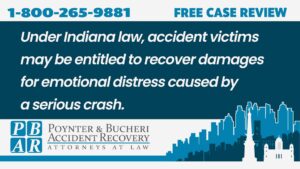
Under Indiana law, accident victims may be entitled to recover damages for emotional distress caused by a serious crash. Emotional distress damages are designed to compensate individuals for the psychological impact of an accident—including anxiety, depression, post-traumatic stress disorder (PTSD), or other mental health conditions.
These emotional injuries often occur alongside physical harm. They can significantly disrupt a person’s ability to work, maintain relationships, or enjoy daily life. In some cases, emotional distress can be just as debilitating as physical injuries.
To pursue these damages, you’ll need to demonstrate that your psychological suffering is directly related to the auto accident.
Documentation Needed To Prove Emotional Distress
To pursue emotional distress damages after an auto accident, you’ll need strong documentation that demonstrates the psychological impact the event has had on your life. Typical forms of evidence include:
- Medical Records: Documentation from therapists, psychologists, or psychiatrists showing diagnoses such as PTSD, anxiety, or depression, along with treatment plans, prescriptions, or therapy notes
- Personal Testimony: Your own written or verbal account detailing how the accident has affected your emotional well-being, daily life, and ability to function normally
- Statements From Family, Friends, or Coworkers: Witness accounts from those close to you describing noticeable changes in your mood, behavior, or mental state since the accident
- Expert Testimony: Assessments from licensed mental health professionals that outline the severity of your condition, the connection to the accident, and the likely long-term effects
- Work Records: Documentation from your employer showing how emotional distress has affected your performance—such as missed work, reduced productivity, or required accommodations
Thorough, timely documentation strengthens your case during the insurance claims process and supports any legal action that may follow. It also helps ensure that emotional distress and related medical expenses are fully recognized and reimbursed. Since emotional injuries can evolve, it’s important to begin gathering this evidence as early as possible for your accident lawyer.
How Indiana’s Modified Comparative Fault Law May Reduce Your Damages
Indiana follows a modified comparative fault system. If you’re more than 50% at fault for a car accident, you can’t recover damages. If you’re 50% or less at fault, you can still recover compensation—but it will be reduced by your percentage of fault.
For example, if you’re awarded $100,000 in a car accident claim but found 20% at fault, you’d receive $80,000.
Because fault can be shared in intersection accidents, you must gather strong evidence—like accident reports, witness statements, and photos—to support your claim and reduce your share of liability.
Actions You Can Take To Avoid Intersection Accidents
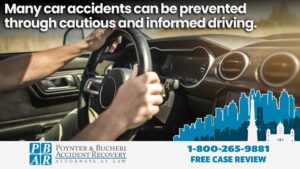
Intersections are among the most common sites for auto accidents—but many car accidents can be prevented through cautious and informed driving.
Smart precautions include:
- Obeying traffic signals and signs
- Watching for pedestrians and cyclists
- Avoiding distracted driving
- Staying aware of surrounding vehicles
- Checking blind spots carefully
- Adjusting your speed and lane position as needed
- Using turn signals consistently
- Being prepared for sudden changes in road or traffic conditions
By taking these proactive steps, you help reduce the risk of car crashes that can lead to serious injuries, medical bills, and costly legal claims.
FAQ
How can I document the scene of an intersection accident?
Documenting the scene of an intersection accident helps support your car accident claim. To preserve evidence, take the following steps:
- Take photos of all vehicles involved, visible damage, skid marks, road signs, and traffic signs.
- Record video of the accident scene from multiple angles, if it’s safe to do so.
- Photograph your injuries as soon as possible after the crash.
- Collect witness names, contact information, and statements.
- Request a copy of the police report once it’s available.
- Write down key details such as the time, date, traffic patterns, and weather conditions.
- Sketch the scene to show vehicle positions, directions, and intersection layout.
Thorough documentation helps protect your rights and supports your claim during insurance negotiations or legal proceedings. An experienced Indianapolis car accident attorney can use this evidence to build a compelling case on your behalf.
Who is liable if a pothole contributed to my intersection accident?
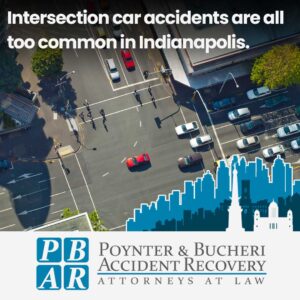
If a pothole played a role in your intersection accident, liability depends on who was responsible for maintaining the road. In general:
- Local Government or Municipality: If the pothole was on a public road, a city, county, or state agency may be liable—especially if they were notified of the hazard and failed to make timely repairs.
- Private Property Owners: If the pothole was located in a private lot or on a privately maintained road, the owner may be responsible for its upkeep and any resulting accidents.
To pursue a claim, you’ll need to show that the pothole created an unreasonable hazard and that the responsible party knew—or should have known—about it and failed to act. Photos, statements, and maintenance records can be crucial pieces of evidence your accident lawyer can use to prove your case.
How much will the initial consultation with an intersection accident attorney cost?
At Poynter & Bucheri, your initial consultation is completely free. We operate on a contingency fee basis, meaning you don’t pay any attorney fees unless we successfully recover compensation for you. For car accident cases resolved before going to trial—and where liability and medical causation are not disputed—our standard fee is just 25% of the settlement. This is significantly lower than the typical 33% to 40% charged by many other law firms.
However, clients remain responsible for any case-related costs, expenses, and medical bills regardless of the settlement outcome.
What driver and witness information should I collect?
After an intersection accident, gather the following information to support your claim:
Driver Information:
- Full name
- Contact details (phone number, address)
- Driver’s license number
- Insurance information (policy number, company name)
- Vehicle details (license plate, make, model, year, registration)
- Employer (if applicable, especially for commercial or rideshare drivers)
Witness Information:
- Full name
- Contact details (phone number, address)
- A brief statement of what they observed (particularly if they saw the cause of the accident)
- Relationship to the accident (e.g., pedestrian, bystander, other driver)
Try to collect this information as soon as possible—witness memories can fade quickly. When you can, take photos of all relevant documents and identification to ensure accuracy.
When should I notify my insurance company after an intersection accident?
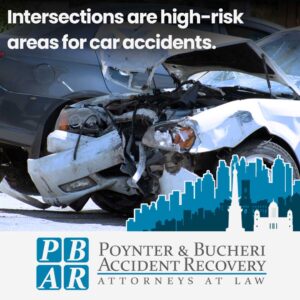
You should notify your insurance company as soon as possible—ideally within 24 to 48 hours of the accident. Prompt reporting is essential for several reasons:
- Policy Requirements: Most insurance policies require timely reporting. Delays could jeopardize your coverage or slow down your claim.
- Preserving Evidence: Early notification ensures evidence—like photos, police reports, and witness statements—is gathered while it’s still fresh.
- Protecting Your Rights: Prompt reporting helps your insurer begin their investigation and protect your rights, especially if the other driver was at fault.
- Avoiding Delays: Fast action can help speed up the claims process, leading to quicker access to compensation for vehicle damage and medical treatment.
When reporting the accident, provide detailed and accurate information. If you’re unsure what your insurance coverage includes, or face pushback from the insurance company, a knowledgeable Indiana car accident lawyer can help clarify your rights and fight for fair compensation.
Fighting for You After an Intersection Accident
An intersection accident can leave you with catastrophic injuries and financial strain. At Poynter & Bucheri, our Indianapolis car accident attorneys will guide you through the legal process and help you claim compensation for your medical bills, lost income, and other damages.
Call 800-265-9881 or click here to schedule your free consultation with a car accident lawyer. Let us help you move forward and hold the at-fault party accountable.
